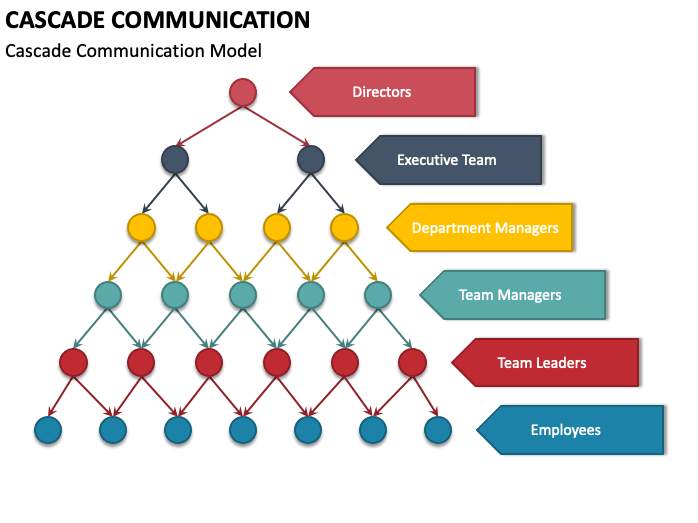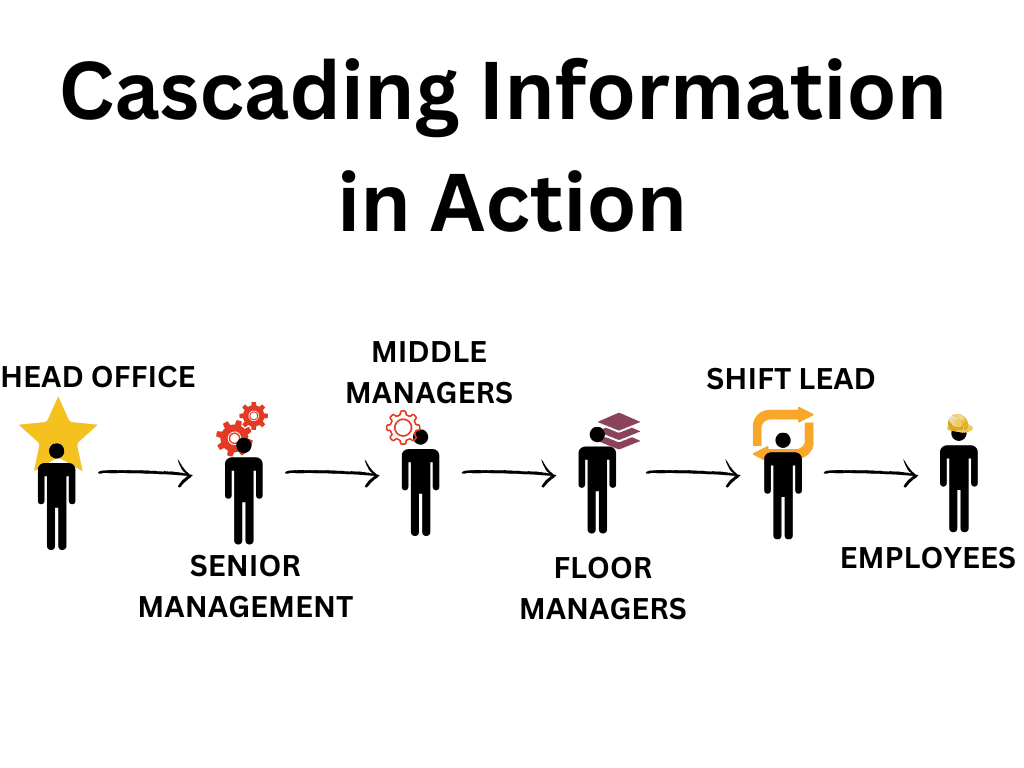Effective communication is essential for enhancing team productivity, improving talent retention, and, ultimately, achieving business success. The Society for Human Resource Management reports that the cost of miscommunication is between $420,000 and $62.4 million annually (the equivalent of £350,000 – £52 million), depending on the organisation’s size. Cascading information is an efficient method to ensure seamless communication of goals, objectives, updates, and any other types of information flow throughout the organisation from top to bottom.
Let’s discuss the essence, principles, and importance of cascading communication for ensuring organisational success.
Table of Contents
What is cascading communication?
Cascade communication involves transferring information from the top of the organisation down to the bottom of the hierarchy through all levels. It establishes the responsibility of the managers of each level to brief their direct subordinates, who in turn have to pass the information to their subordinates. The process is like an information waterfall and continues until everyone is informed. The diagram below provides a clear visualisation of the principle of cascading information.

With centralised internal communication methods, the information originates from a single point and is distributed to all employees via multiple channels. Cascading communication, however, relies on managers personally passing information down an organisational structure. Involved more directly in the process, all managers in the organisation must take ownership of the information they deliver to their subordinates.
Having the information originate from a source of trust and authority implies a more meaningful and justifiable way of presenting the information, but in practice, the inefficiencies involved often outweigh the benefits. Passing information down through multiple levels of the hierarchy ultimately takes a long time. Not only does this run the risk of the information being outdated by the time it reaches employees, but it often results in important messages being lost from person to person. This is why large organisations tend to opt for centralised systems for mass internal communications.
What is the importance of cascading information?
Research shows that a third of HR managers point to the lack of open and honest communication as the reason for low employee morale, engagement, and productivity. In fact, 38% of the participants in the same survey believe improved and efficient communication is the best remedy for disconnected employees and organisational failures.
Cascading information for internal communication ensures that all employees remain informed and up to date about significant developments, changes, and decisions, which can ultimately impact the way to organisation operates. It creates a culture of transparency and openness within the organisation. Employees feel valued and trusted, which is one of the most effective ways to improve engagement and productivity.
By showing employees they aren’t left behind and are promptly updated about important decisions and developments, the organisation’s leadership can build trust and loyalty with their workers and teams.
Information cascading models
Cascading information is necessary because CEOs and other high-level leaders cannot personally reach all employees simultaneously. When implemented correctly, cascading communication strategies can bridge the gap between HQ and frontline workers and promote a culture of transparency and trust. Here’s a simple illustration of cascading communication in action.

This approach also allows managers to take responsibility for communication and prevents them from hiding behind directives from above. As a result, managers are more likely to maintain consistent and accurate messaging.
What is the difference between herding and information cascade?
In general, herd behaviour and information cascade are similar concepts that refer to the decision-making process, where a person makes their choices based on external information and opinions. Herd behaviour involves individuals copying the majority’s decision assuming that, if most people opt for a particular solution, it can’t be wrong. In contrast, an information cascade occurs when people base their decisions on the directions of another person in a similar scenario.
In a communication context, relying on herd behaviour can be risky, as the majority may not be correct. Therefore, leaders should avoid this method to convey important decisions or changes to their employees. A cascading communication approach is seen as a more reliable option of the two, with the decision-driving information relayed from a trusted source who takes responsibility for the data communicated.
The most effective methods of creating a communication cascade
To create an effective communication cascade, it’s crucial to use appropriate delivery methods for different types of internal communication. For instance, topics such as office closures, moves, or mergers and acquisitions may require direct communication from a business leader. In contrast, managers communicate day-to-day issues and developments. Regardless of the information’s nature, ensuring it’s clear, accurate, and with the appropriate level of impact is vital.
When communicating with your team directly, it’s essential to establish open channels of communication. Additionally, it’s crucial to ensure that the information you receive from higher-ups is the same information you pass to your team to avoid confusion or misinformation.
How to implement a cascading information strategic plan
There are three important steps for implementing your cascading information strategy.
Establish feedback loops
Leaders should avoid assuming employees have no questions or concerns after receiving significant decisions or changes. Instead, create a feedback loop where employees can air their thoughts, ideas, and concerns.
One way to set a feedback loop is through employee communication portals. These portals can provide a platform for employees to ask questions, seek clarification, or express their concerns. Alternatively, you can conduct regular surveys to gather feedback from employees.
By doing so, leaders can ensure that employees are informed, engaged, and heard, fostering a more productive and cohesive workforce.
Craft the right messages
Creating the right message is crucial when effectively implementing a strategic plan for cascading information. Some messages are more complex than others, and you should pay attention to conveying the message in the clearest, most accurate way possible. How?
Start by fully comprehending the information and seeking clarification from the CEO or peers before communicating with your team. To prevent confusion and ensure that all recipients understand the message clearly and easily, use straightforward language and avoid technical jargon. Match the tone of the message to the subject matter and the audience. Double and triple-check the content to avoid any miscommunication.
Finally, consider the timing of the message. For instance, communicating a significant change to employees on a Friday afternoon may not be effective, as they may need more time to process the information or ask questions.
Remember that it’s crucial to time the communication when employees can give their full attention to the message and have the opportunity to ask questions and seek clarification.
Leverage digital signage
Cascading information requires setting the right technology and systems. In this context, digital signage is one of the most valuable tools for speeding up message delivery times. Instead of waiting for key messages to filter through multiple chains of management, they ensure all employees can absorb important information within minutes.
The benefits also extend to non-desk and hybrid work arrangements in large companies operating in logistics, manufacturing, hotels, restaurants, and healthcare institutions, where most employees may not have access to corporate accounts, emails or intranets. In this case, screens can be placed in high-traffic areas to ensure that all employees are able to receive key messages.
Implementing a cloud-based digital signage solution can help to amplify the reach of internal communications campaigns. Important messages can play consistently throughout the day, reaching employees multiple times. This, in turn, increases the chance of key messages being absorbed. Having the ability to remotely update multiple screens in real time helps the messaging stay consistent. It removes human error where messages can be changed and lost when moving from person to person. This helps to combat the downsides associated with traditional cascading communication structures.
Want to boost the efficiency of your cascading communication strategy with screens? Our team will be happy to help you. Speak with an expert today!
